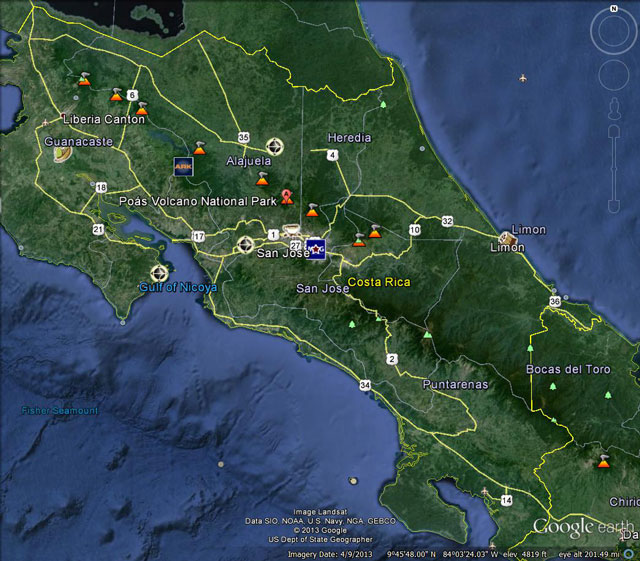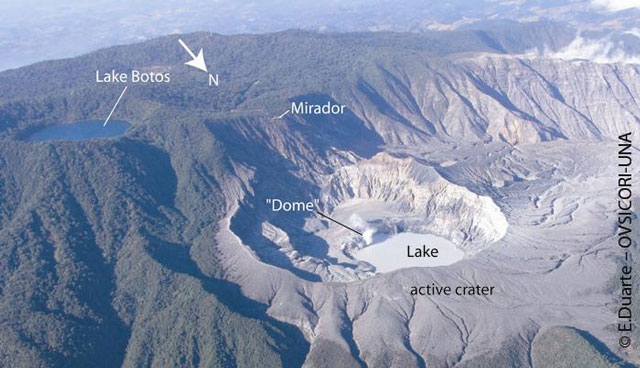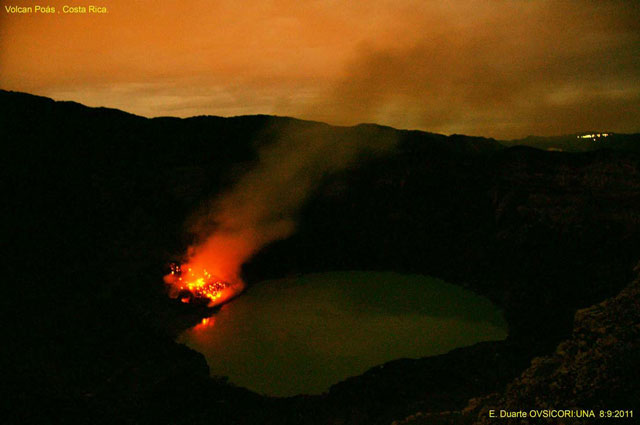Report on Poas (Costa Rica) — September 2013
Bulletin of the Global Volcanism Network, vol. 38, no. 9 (September 2013)
Managing Editor: Richard Wunderman.
Poas (Costa Rica) Decreasing number of phreatic eruptions after 2011 through 2013
Please cite this report as:
Global Volcanism Program, 2013. Report on Poas (Costa Rica) (Wunderman, R., ed.). Bulletin of the Global Volcanism Network, 38:9. Smithsonian Institution. https://doi.org/10.5479/si.GVP.BGVN201309-345040
Poas
Costa Rica
10.2°N, 84.233°W; summit elev. 2697 m
All times are local (unless otherwise noted)
In an activity report on 31 August 2011, the Observatorio Vulcanologico y Sismologico de Costa Rica-Universidad Nacional (OVSICORI-UNA) indicated that Poás had experienced intense phreatic activity between 2006 and mid-2011. In June 2011, however, the frequency of eruptions began to decrease dramatically. The report also indicated that Laguna Caliente, the hot, acid crater lake on the northern summit, had shrunk by about 94 percent between 2006 and mid-2011; during this same period, the lake's pH had decreased from 1.22 to minus 0.72 and its water temperature had increased from 32°C to 62°C. One explosion, on 25 December 2009, apparently opened a more permanent vent at the crater lake's bottom. On the S edge of the lake is a dome (that OVSICORI-UNA sometimes in their reports refers to as a "cryptodome"), where frequent, intense degassing has occurred. The lake exhibits vigorous convective activity, and acid rain is frequently observed.
Our previous report (BGVN 36:04) discussed activity through February 2011. This report presents activity between that date and 31 December 2013. Figure 100 indicates the location of the volcano in Costa Rica. A photo of the active crater and surrounding area is shown in figure 101.
Activity in 2011. An OVSICORI-UNA activity report from November 2011 and an annual 2012 summary indicated that the temperature of the dome had increased dramatically during early 2011 as the result of super-heated gas released through the dome. The temperature, measured by thermocouple, peaked in August 2011 at 890°C, and then decreased steadily thereafter through at least the end of 2012, when the temperature was about 100°C. In early 2011, incandescence could be seen at night; however, during June-September, it could also be seen during the day. This phenomenon had not occurred since 1981. OVSICORI-UNA speculated that the changes could be either from a recent magma intrusion or a change in the hydrothermal plumbing system.
A news article (Inside Costa Rica) reported that a team of geologists and volcanologists from the Universidad de Costa Rica visited Poás on 25 May 2011 and observed 18 phreatic explosions from Laguna Caliente during a three-hour period. According to the article, the volcano normally produced 1-2 explosions per day.
On 23 July 2011, OVSICORI-UNA scientists visited Poás to document changes during the previous weeks. They observed fumaroles with vigorous bluish emissions in the fractured rock about 40 m above the lake surface. Those emissions produced incandescence observable during the daylight. The emission temperature was 670°C at the dome's mid-wall. A separate report noted that the temperatures at the dome were unusually high, in the range of 700-890°C between June and October 2011. Scientists noted that on the SE shore of Laguna Caliente, a subtle, semicircular scarp observed a few months earlier had rapidly progressed to a sharp scarp. The 60-m-wide, 2.5-m-high scarp was degassing and geyser activity was observed on the W end, next to the lake.
OVSICORI-UNA visited the volcano again on 8 September 2011, and observed that two newly formed cavities at the N base of the dome had merged into a crater that was 25 m long and 7-10 m wide. The scientists also found incandescence reflected in the gas plume about 80 m from the edge of the lake to near the top N edge of the dome (figure 102 and 103). OVSICORI-UNA reported that a new fumarole had appeared on the crater during August-September 2011.
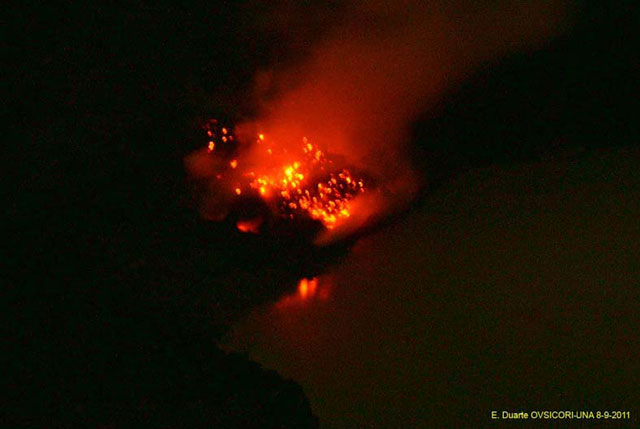 |
Figure 103. Night view (at 1800) showing Poás' incandescence on the dome and fumarolic activity. Photo taken from the E on 8 September 2011. Courtesy of OVSICORI-UNA. |
According to OVSICORI-UNA, fumarolic activity continued during October 2011, with bluish gas plumes rising more than 1 km from the dome. Toward the end of the month, the fumarolic activity as well as incandescence from the dome had decreased. Phreatic activity continued. The lake temperature was 55°C and the level had risen 22 cm between 14 September and 27 October 2011.
OVSICORI-UNA reported that during fieldwork on 16 December 2011 scientists observed new geyser activity from a vent that had formed earlier in 2011 on the dome's N flank. A water-and-mud fountain rose 5-6 m high and flowed into the lake, resulting in a terrace along the S shore. Gas-and-steam plumes rose from the dome.
Activity in 2012. According to OVSICORI-UNA, at least 44-47 phreatic explosions were observed in 2012, either by the rangers of the Parque Nacional Volcán Poás (Poás Volcano National Park) or in seismic recordings. The number per month for the year ranged from 0 (in September) to 10 (in October). Sometimes these explosions were characterized by large bubbles of gas and liquid, under 500 m high. For example, during May 2012, eruptions occurred on 6, 15, 20 and 26 May. The eruption on 15 May was preceded by about 6 hours of very low amplitude harmonic tremor. Administrators at the National Park witnessed the explosion and reported that sediment, water, rock fragments, and plumes were ejected ~500 m above the lake surface. The lake level dropped ~0.9 m between 8 and 29 May, while the water temperature was steady during this period at ~48°C. Dome fumarole temperatures decreased during 2012, from ~700°C to ~100°C.
OVSICORI reported that higher amplitude, more frequent phreatic eruptions occurred in October 2012, especially during 18-27 October. Two phreatic explosions occurred on 27 October 2012. One of them ejected water, sulfur-rich sediments, and rock fragments onto the S and SW edges of the crater floor. According to a news article (The Tico Times), local residents heard a loud rumble at about 0100 on 28 October; a phreatic explosion ejected sediment 500 m above the lake, and produced ashfall several hundred meters away.
Between January and October 2012, the lake level decreased about 4 m; in November and December, the lake level rose by the same amount due to the high precipitation common at this time of year. Strong rainfall in November eroded the N flank of the dome.
Seismicity remained stable in 2012, with less than 200 daily earthquakes, mostly shallow low-frequency events. During 2012, the number of volcano-tectonic earthquakes remained low. The only significant seismicity occurred during 5-7 September, following the 5 September Nicoya earthquake (Mw 7.4) in the NW part of Costa Rica.
Activity in 2013. According to OVSICORI-UNA's annual report for 2013, seismic activity remained stable, with 10-150 earthquakes daily. Isolated small magnitude, shallow, volcano-tectonic earthquakes also occurred. Tremors were recorded infrequently and were of short duration. Hybrid earthquakes with large amplitudes (up to 3 cm2 reduced displacement) began in September, peaked in October, and fell in November.
In March 2013, OVSICORI-UNA began to measure the concentration of CO2, SO2, and H2S, using a portable multi-gas station provided by Italy's Istituto Nazionale di Geofisica e Vulcanologia (National Institute of Geophysics and Volcanology, INGV). In April 2013 the SO2 emission, as measured by a portable DOAS (Differential Optical Absorption Spectroscopy), was 120 /-30 metric tons per day.
In 2013, the dome temperature rose from 100°C in January to values above 500° C during the middle of the year, resulting in incandescence observed at night during May 2013. For example, maximum temperatures of 575°C and 450°C were recorded on 8 and 30 May, respectively. Later in the year, temperatures decreased to as low as 200°C in October, before rising somewhat again. Before 2013, a thermocouple was used to measure temperatures; thereafter, both a thermocouple and a remote infrared camera were used.
Lake activity in 2013 was very similar to that reported for 2012, again characterized by sporadic phreatic eruptions (figure 104). The number of eruptions per month ranged from 4 (March, April, July) to 9 (May, October). The water level remained relatively constant at 4 m until about June-August when it decreased to as low as about 1.5 m, before rising again. During 2013, no significant change in water temperature (about 45-50°C) or pH (0-0.3) was noted, similar to measurements in 2012. For example, the lake temperature was about 46°C on 8 May 2013 and 48°C on 8 May 2012. The pH was 0.03 on 8 May 2013, compared to 0.07 on 8 May 2012.
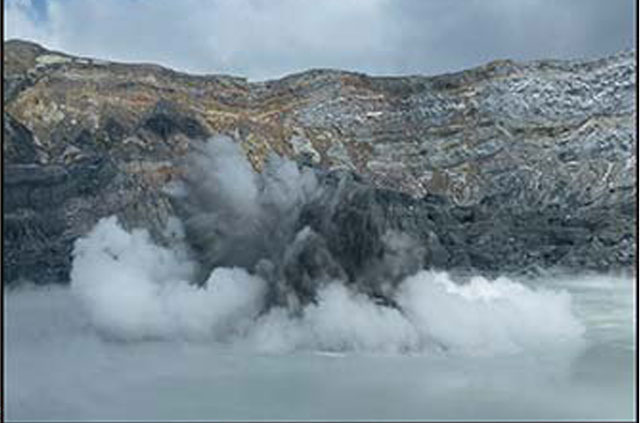 |
Figure 104. Photo of phreatic eruption from Poás' Laguna Caliente on 20 August 2013. Courtesy of OVSICORI-UNA (G. Durán). |
During 2013, rainfall was substantially less acidic, reflecting a decrease in the release of gases and heat through the active crater. Fumarolic activity was variable.
During the early morning hours on 2 and 3 June, residents reported a gas plume rising 1 km above the crater floor. OVSICORI-UNA observed that recent plumes had been hot (450-575°C) and rich in sulfur dioxide, giving the plumes a bluish-white color.
Geological Summary. The broad vegetated edifice of Poás, one of the most active volcanoes of Costa Rica, contains three craters along a N-S line. The frequently visited multi-hued summit crater lakes of the basaltic-to-dacitic volcano are easily accessible by vehicle from the nearby capital city of San José. A N-S-trending fissure cutting the complex stratovolcano extends to the lower N flank, where it has produced the Congo stratovolcano and several lake-filled maars. The southernmost of the two summit crater lakes, Botos, last erupted about 7,500 years ago. The more prominent geothermally heated northern lake, Laguna Caliente, is one of the world's most acidic natural lakes, with a pH of near zero. It has been the site of frequent phreatic and phreatomagmatic eruptions since an eruption was reported in 1828. Eruptions often include geyser-like ejections of crater-lake water.
Information Contacts: Observatorio Vulcanologico y Sismologico de Costa Rica-Universidad Nacional (OVSICORI-UNA), Apartado 86-3000, Heredia, Costa Rica (URL: http://www.ovsicori.una.ac.cr/); Inside Costa Rica (URL: http://www.insidecostarica.com/); The Tico Times (URL: http://www.ticotimes.net/).


